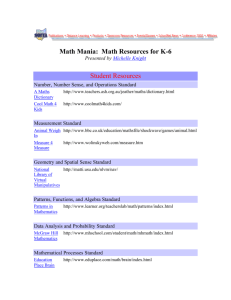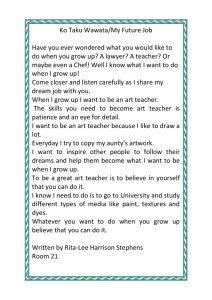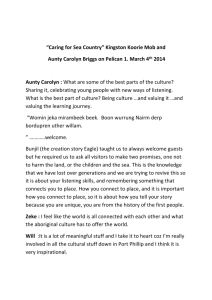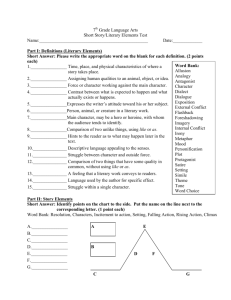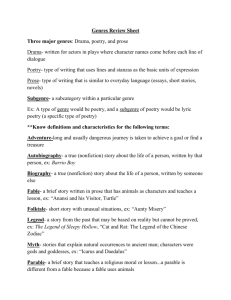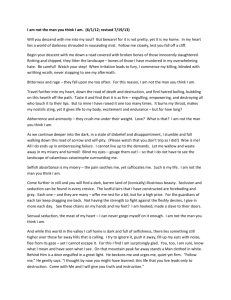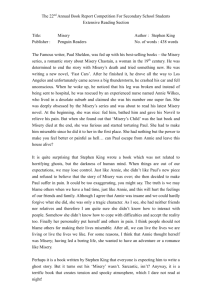Aunty Misery
advertisement
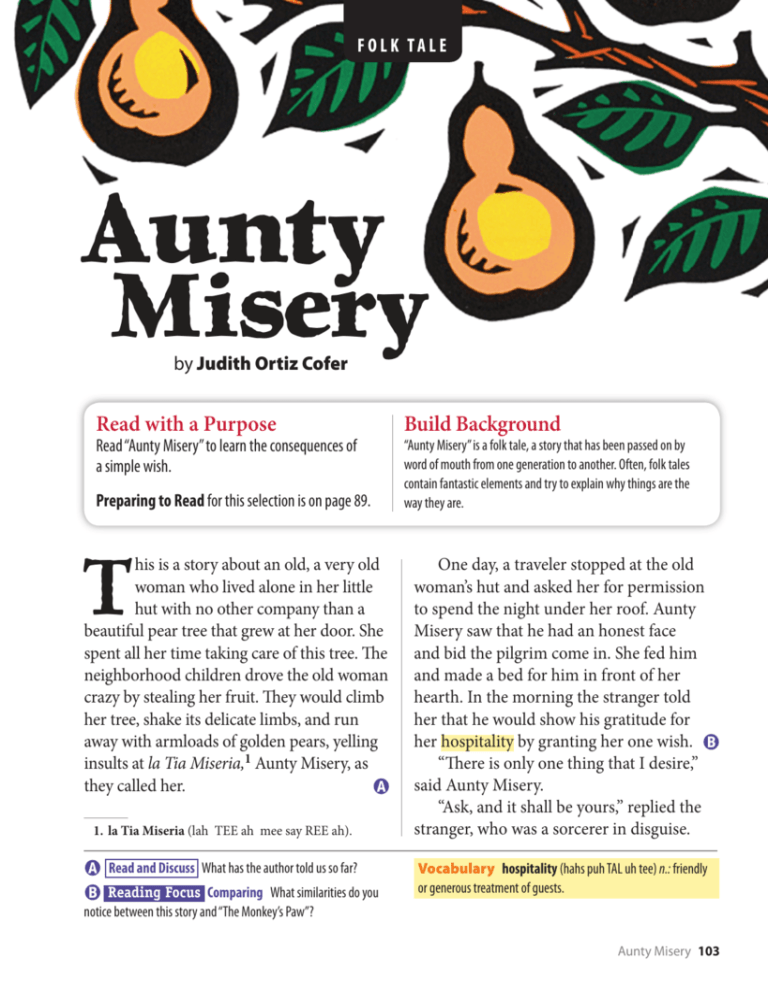
FOLK TALE Aunty Misery by Judith Ortiz Cofer Read with a Purpose Build Background Read “Aunty Misery” to learn the consequences of a simple wish. “Aunty Misery” is a folk tale, a story that has been passed on by word of mouth from one generation to another. Often, folk tales contain fantastic elements and try to explain why things are the way they are. Preparing to Read for this selection is on page 89. T his is a story about an old, a very old woman who lived alone in her little hut with no other company than a beautiful pear tree that grew at her door. She spent all her time taking care of this tree. The neighborhood children drove the old woman crazy by stealing her fruit. They would climb her tree, shake its delicate limbs, and run away with armloads of golden pears, yelling insults at la Tia Miseria,1 Aunty Misery, as they called her. A 1. la Tia Miseria (lah TEE ah mee say REE ah). A Read and Discuss What has the author told us so far? B Reading Focus Comparing What similarities do you One day, a traveler stopped at the old woman’s hut and asked her for permission to spend the night under her roof. Aunty Misery saw that he had an honest face and bid the pilgrim come in. She fed him and made a bed for him in front of her hearth. In the morning the stranger told her that he would show his gratitude for her hospitality by granting her one wish. B “There is only one thing that I desire,” said Aunty Misery. “Ask, and it shall be yours,” replied the stranger, who was a sorcerer in disguise. Vocabulary hospitality (hahs puh TAL uh tee) n.: friendly or generous treatment of guests. notice between this story and “The Monkey’s Paw”? Aunty Misery 103 “I wish that anyone who climbs up my pear tree should not be able to come back down until I permit it.” “Your wish is granted,” said the stranger, touching the pear tree as he left Aunty Misery’s house. And so it happened that when the children came back to taunt the old woman and to steal her fruit, she stood at her window watching them. Several of them shimmied up the trunk of the pear tree and immediately got stuck to it as if with glue. She let them cry and beg her for a long time before she gave the tree permission to let them go on the condition that they never again steal her fruit, or bother her. Time passed and both Aunty Misery and her tree grew bent and gnarled with age. One day another traveler stopped at her door. This one looked untrustworthy to her, so before letting him into her home the old woman asked him what he was doing in her village. He answered her in a voice that was dry and hoarse, as if he had swallowed a desert: “I am Death, and I have come to take you with me.” C Thinking fast, Aunty Misery said, “All right, but before I go I would like to pluck some pears from my beloved tree to remember how much pleasure it brought me in this life. But I am a very old woman and cannot climb to the tallest branches where the best fruit is. Will you be so kind as to do it for me?” With a heavy sigh like wind through a tomb, Señor Death climbed the pear tree. Immediately he became stuck to it as if with glue. And no matter how much he cursed and threatened, Aunty Misery would not allow the tree to release Death. Many years passed and there were no deaths in the world. The people who make their living from death began to protest loudly. The doctors claimed no one bothered to come in for examinations or treatments anymore, because they did not fear dying; the pharmacists’ business suffered too because medicines are, like magic potions, bought to prevent or postpone the inevitable; priests and undertakers were unhappy with the situation also, for obvious reasons. There were also many old folks tired of life who wanted to pass on to the next world to rest from miseries of this one. D La Tia Miseria was blamed by these people for their troubles, of course. Not wishing to be unfair, the old woman made a deal with her prisoner, Death: if he promised not ever to come for her again, she would give him his freedom. He agreed. And that is why there are two things you can always count on running into in this world: Misery and Death: La miseria y la muerte.2 C Literary Focus Patterns What parallel episodes D Read and Discuss What is the connection between Death can you find in both “Aunty Misery” and “The Monkey’s Paw”? being stuck in Aunty Misery’s tree and what is going on in the rest of the world? Vocabulary gnarled (nahrld) adj.: covered with knots; twisted. 104 Unit 1 • Collection 1 2. y la muerte (ee lah MWEHR tay). Aunty Misery 105 SKILLS FOCUS Literary Skills Analyze subplots and parallel episodes; analyze literary patterns. Reading Skills Compare and contrast stories. Vocabulary Skills Demonstrate knowledge of literal meanings of words and their usage. Writing Skills Establish and develop setting. Aunty Misery Respond and Think Critically Quick Check Literary Analysis 1. Who is Aunty Misery’s first visitor? What wish of hers does he grant? 2. What bargain does Aunty Misery make with her second visitor? Read with a Purpose 3. What happens as a result of Aunty Misery’s wish? Reading Skills: Comparing and Contrasting 4. Now, fill in the second column of your chart. Use your chart to answer questions 10 and 11. “The Monkey’s Paw” Parallel episodes within a story three wishes Literary patterns across stories mysterious guest arrives magical object “Aunty Misery” Vocabulary Check Match the Vocabulary words with their definitions. 5. gnarled a. twisted 6. hospitality b. generosity 106 Unit 1 • Collection 1 7. Identify What story clues reveal that Aunty Misery is clever? 8. Interpret The folk tale states that there are two things you can always count on in this world: misery and death. What does that saying mean? 9. Extend According to the folk tale, what happens in the world when there is no death? What other effects can you imagine if there were no death? Literary Skills: Literary Patterns 10. Identify What parallel episodes can you find in “Aunty Misery”? 11. Interpret Compare the outcomes of Aunty Misery’s wish with those of Mr. White’s wishes. What can you conclude about the consequences of human desire? Think as a Reader/Writer Use It in Your Writing Cofer uses short, simple sentences in the telling of this folk tale. Choose a setting that intrigues you—it can be imaginary or real. Using Cofer’s simple style, try writing a paragraph that describes the setting. Observe the effect of this style. Now, rewrite your paragraph using longer, more complex sentences. How does the overall effect of the description change? COMPARING TEXTS SKILLS FOCUS Literary Skills Analyze subplot and parallel episodes; analyze literary patterns. Reading Skills Compare and contrast stories. Writing Skills Write comparison-contrast essays. The Monkey’s Paw / Aunty Misery Writing a ComparisonContrast Essay Use It in Your Writing Write an essay comparing the patterns you find within and across “The Monkey’s Paw” and “Aunty Misery.” To help plan your essay, review the chart you completed after you read each story. The chart will help you focus on story elements that are similar and different. Also, ask yourself these questions: • How does the pattern of wishes set in motion each story’s events? • What are the outcomes of Mr. White’s and Aunty Misery’s wishes? How are these outcomes similar and different? • What does the ending of each story suggest about the consequences of people’s desires being fulfilled? You do not have to write about all of these elements in your essay. Explore the elements that most interest you. There are two basic ways you can organize the body of your essay: 1. The Block Method If you choose this organizational structure, you will discuss one story at a time. Your first few paragraphs might look like this: Paragraph 1: “The Monkey’s Paw” (parallel episodes; other literary patterns; lesson about life) Paragraph 2: “Aunty Misery” (parallel episodes; other literary patterns; lesson about life) 2. The Point-by-Point Method If you use this organizational structure, you will discuss each literary element in turn, explaining how it is used in each story. Your first three paragraphs might look like this: Paragraph 1: Parallel episodes in “The Monkey’s Paw” and in “Aunty Misery” Paragraph 2: Common literary patterns in “The Monkey’s Paw” and in “Aunty Misery” Paragraph 3: Lessons about life in “The Monkey’s Paw” and in “Aunty Misery” At the end of your essay, tell which story you prefer and why. Which story challenged you more as a reader? Explain your opinions. Evaluation Criteria for a Comparison-Contrast Essay An effective comparison-contrast essay • uses the opening paragraph to clearly state what is being compared and contrasted • conveys a main idea in a thesis statement • is organized logically and effectively • cites appropriate details or passages from the text to support ideas • has been carefully proofread for spelling, punctuation, and grammar errors After reading these stories, what new idea about wishes and desires do you have? Explain. Wrap Up 107
